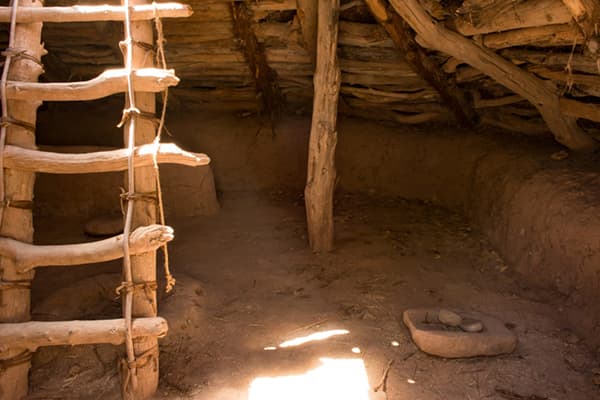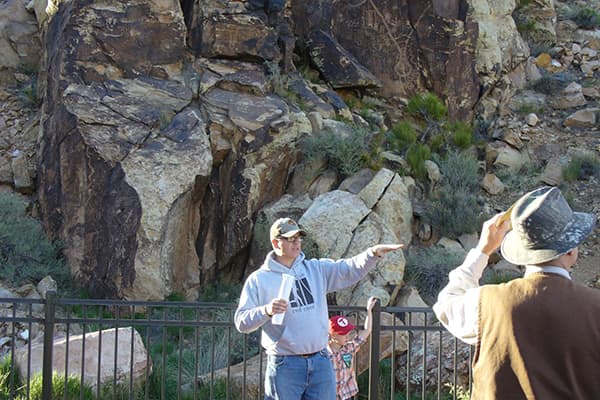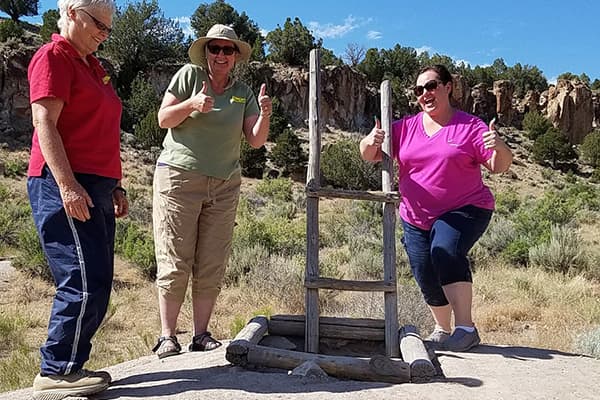Voices of the Ancient Institute Schedule

(Courtesy of Jim Lillywhite, St.George News)
The workshop will begin on Sunday evening with a Welcome Reception at the Frontier Homestead State Park in Cedar City. We will introduce the staff, engage everyone in a team-building activity, and review program goals and the itinerary. A performance by Paiute singers, and a blessing by Virgil Johnson, a Goshute elder, will follow. The ceremony will engage all the senses, invite participants to discover the Fremont, and connect them to living descendants. Participants will tour the historic and precontact shelters on the property, which will prepare them to find commonality among all cultures, start their journey into the Fremont world, and begin to reimagine American history.

(Courtesy of The Spectrum/Jordan Allred)
Guiding Question: How can oral tradition and primary documents give voice to the Fremont; and, consequently, other people who are underrepresented in the American narrative?
Landmarks: Southern Utah University Library and Special Collections
Readings: Project Archaeology: Investigating Shelter curriculum guide; Why the Moon Paints Her Face Black - Tom; Tribal Nations and the United States digital file.
Darren Parry, Virgil Johnson, and Eileen Quintana will set the stage for the entire institute by providing an overview of the history of Native Americans since European contact and the issues tribal people face in modern times. Participants will review concepts and readings assigned in the online course prior to arrival and begin connecting the past and present through archaeological inquiry (Project Archaeology: Investigating Shelter) on the SUU campus.
In breakout groups, participants will examine ethnographic objects in the Special Collections Library at SUU and learn how to conduct an oral history interview. The group will meet in the Special Collections to learn from Eleanor Tom, Paiute Elder, and Jedidiah Rogers, historian. Mrs. Tom will read the story Why the Moon Paints Her Face Black in Paiute and share some of the traditions and stories passed down by her grandmothers. Participants will have an opportunity to ask questions and make meaningful connections. Kathleen Broeder, Archivist, will introduce participants to the historic collections that contain photographs, artifacts, and transcribed oral histories of the Paiute people. Alternately, in the adjacent auditorium, Mr. Rogers will share his experience with recording oral histories and will show teachers how to conduct an oral history interview, a valuable skill for strengthening identity and familial connections.

Guiding Question: How does exploring a cultural landscape broaden and deepen our understanding of how people adapted to diverse environmental conditions?
Landmarks: Paragonah Mounds Village and Parowan Gap Petroglyphs
Readings: “The Fremont” Archaeology Southwest magazine; Investigating a Fremont Pithouse curriculum; Paragonah Mounds site form; GIS for Teachers – A Guide to Authentic K-12 Integration and Application-Bunin; Drought in Utah-Utah Division of Water
Participants explore the archaeology of the Parowan Valley. At the Paragonah Mounds site, participants will see the remains of one of the largest Fremont villages ever documented. With site form in hand, Jeanne Moe and Virgil Johnson will provide a short introduction to the site and invite participants to make some preliminary observations about the landscape. With Rich Talbot, the group will conduct a short systematic survey of the site, which will provide an opportunity to feel the land under their feet and discover the artifacts left by the ancient inhabitants and discover the principles of stewardship and preservation of archaeological sites and culturally significant places. Eileen Quintana and Mr. Johnson may share specific aspects of cultural knowledge related to nature, ancestors, and sacred sites. Parowan Gap is an extensive collection of petroglyphs that illuminates the rich artistic legacy of the Fremont and prepares participants to investigate the archaeology and oral history of rock art.
After experiencing and applying the tools of archaeological inquiry and place-based learning, participants will learn the basics of geospatial science in relation to cultural landscapes. David Maxwell, GIS Specialist, will show teachers how to use online software and StoryMaps to explore the ancient landscape of the Fremont culture. GIS for Teachers will help participants implement this tool to enhance student learning. Instructors will model lessons from the Investigating a Fremont Pithouse curriculum. This investigation provides lesson plans that allow students to analyze authentic data from the pithouse that was excavated at the Five Finger Ridge village site. Archaeologist and Curator, Barb Frank will introduce teachers to artifacts from the shelter that they are investigating and establish the conceptual framework for visiting Fremont Indian State Park and meeting the living descendants featured in the curriculum the following day.
Optional evening excursion: Trip to Cedar Breaks National Monument, led by Virgil Johnson

Guiding Question: How can investigating a Fremont pithouse deepen our understanding of human resilience, relationships, and values?
Landmarks: Fremont Indian State Park
Readings: “The Fremont” Archaeology Southwest; Investigating a Fremont Pithouse curriculum; Excerpts from Five Finger Ridge archaeological report
Upon arrival at Fremont Indian State Park, participants will make observations about the landscape, environment, wildlife, plant life, and cultural features. This exercise will include some questions, like how does this area differ from the Parowan Valley? And, how can this inform our understanding of the land use and adaptations of the Fremont and the Paiutes? Instructors will lead teachers in an engaging museum activity, where participant teams use observation and inquiry to become experts on one artifact in the exhibit. They will also use the rock panel exercise from Investigating a Fremont Pithouse to read the interpretations of Paiute Elders, Rick and Rena Pikyavit in front of the actual panel. Teachers will have free time to explore the exhibits and/or take short hikes on the surrounding petroglyph trails. Rick and Rena Pikyavit will provide their perspectives on the Fremont and teachers can engage in meaningful conversations with them. Virgil Johnson and Eileen Quintana will lead the group in learning traditional skills including cordage production and grinding pinyon nuts.

Guiding Question: How does rock art (writing) chronicle the history and culture of the Fremont people, and what does it communicate about the natural world in which they lived?
Landmarks: Black Point Archaeological Site
Readings: Project Archaeology: Investigating Rock Art curriculum; “Fremont Rock Art” Archaeology Southwest; Place-Based Education
At Black Point, an archaeological site on public lands, participants will hike to three small ancient rock shelters where they will team-document adjacent rock art panels, record their observations, create a sketch map, take photos, and take GPS points. Content expert and Paiute ethnobotanist, Autumn Gillard, will provide information about the local environment and Native plant use. Her knowledge will provide context for understanding human cultures and environmental adaptations and give teachers an engaging place-based learning experience. At SUU, Charmaine Thompson, Forest Service archaeologist, will demonstrate a tree-ring activity that teachers can use in their classes; tree rings provide important information on past climates. Instructors will model two of the rock art lessons in Investigating Rock Art; one of which takes participants to the Southern Utah Museum of Art to analyze a modern painting. Virgil Johnson will introduce teachers to rock art lessons for more effective classroom learning and teachers will create rock art; a messy, hands-on experience for both teachers and students.
Optional evening experience: Paiute Night Sky Presentation, led by Autumn Gillard

(NPS)
Guiding Question: How can building diverse communities of respect help preserve the cultural heritage of all Americans for the benefit of future generations?
Landmarks: Paiute Indian Tribe of Utah Offices and Pow Wow Grounds
Readings: Paiute Indian Tribe of Utah restoration story on the website; Bear River Massacre: A Shoshone History-Parry; Select Articles: “What Makes Difficult History Difficult?” and “Teaching the Violent Past”
In the classroom, participants will explore the importance of stewardship of archaeological sites and past cultures from a Native perspective and in accordance with existing preservation laws. Darren Parry will share insights from his book and explore how to teach difficult or hard history in classrooms. Graduates of the Voices of the Ancients Institute in 2021 and similar professional development events will meet with participants to help them create a classroom implementation plan. Awards will be presented, and the afternoon will close with a traditional round dance. Participants will tour the Paiute Indian Tribe of Utah Offices and Pow Wow Grounds, enjoy dinner prepared by the Restoration Pow Wow Committee, and meet for a cultural program. The SUU Mountain Center is an alternate venue for the evening program. Using a “talking stick” participants will share their thoughts and feelings about their experience.

